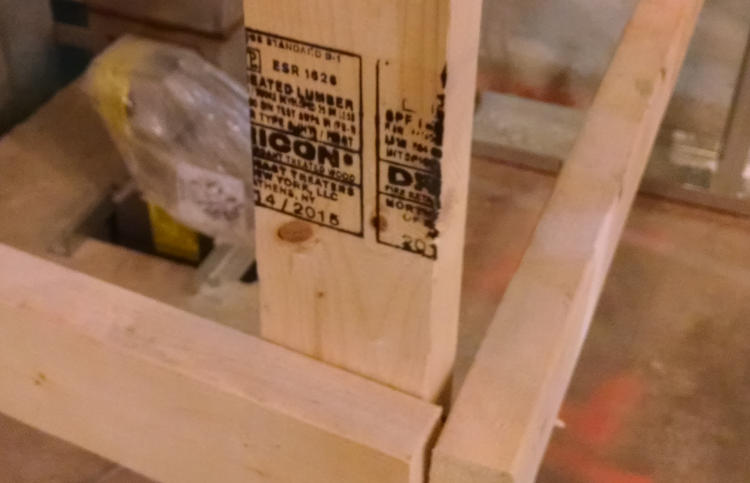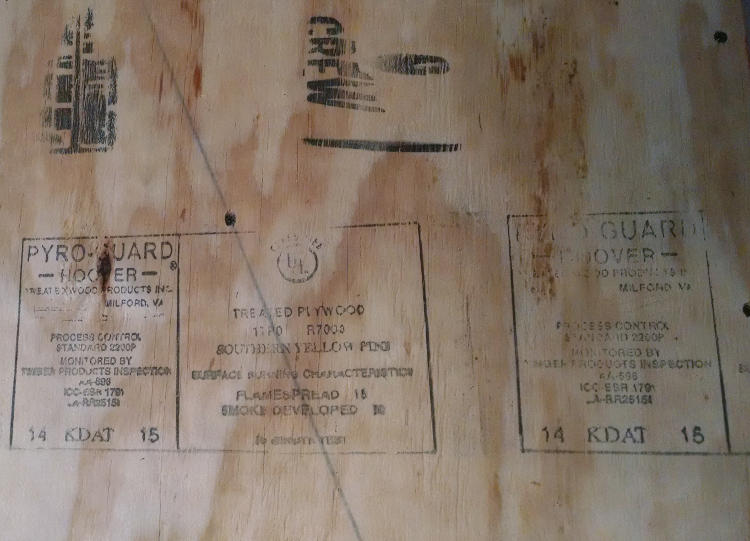Whether installing fire rated wood panels due to personal safety concerns or because of adherence to the specific building codes and jurisdiction in which you live, is important to know something about the various aspects of fire retardant treated wood (FRT) and its benefits. Fire retardant treating is available for both plywood and for building lumber, which together comprise the majority of the structural wood elements for most buildings. The sections below will describe the types of FRT wood available, how they are made, and their various uses.
Creation of FRT Wood
Fire retardant wood products are typically created through the use of organic and inorganic salts, which are infused into the wood through water-based solutions under pressure. The end result is a product that has 2.5 to 5.0 pounds of salts per cubic foot of wood product. Not all species of wood are treatable, and the species that is certified for treatment for lumber may not necessarily be certified for treatment as plywood and vice-versa.
Mechanism of Fire Retarding Wood Products
Fire retardants in wood work through two primary mechanisms. The first is reduction of wood flammability by reducing flame travel rate, thereby slowing down the combustion process. Secondly, the chemicals reduce the rate which heat is released from the wood during a fire. The fire retardants alter the vapors released during the combustion process by making them less volatile.
Testing and Labeling of Fire Retardant Wood
Testing and labeling of FRT wood is essential to maintaining the quality and consistency of manufactured FRT products. Components of the testing and labeling process are included below:
Flame Spread Number
The flame spread number is determined through evaluation of surface burning characteristics by using a standard fire test. A value of zero is assigned items that are noncombustible and a value of 100 is assigned to red oak flooring, to create a consistent scale. The flame spread number is then used to classify the wood as A, B, or C. Class A has a flame spread number of 25 or below, class B from 26 to 75, and class C from 76 to 200. In order for FRT wood to be substituted for noncombustible materials, it must have a class a rating.
| CLASS | FLAME SPREAD |
|---|---|
| Noncombustible | 0 |
| Class A | 0 - 25 |
| Class B | 26 - 75 |
| Class C | 76 - 200 |
Smoke Developed Number
The smoke developed number is determined during the same fire test that is used to assess the point spread number. Like the flame spread number, the smoke developed during the burning of red oak flooring is also used as a baseline and is assigned a number of zero.
Fire Retardant Plywood Formulations
FRT plywood is typically created using one of two types of chemical formulations: Type A and Type B. Type A FRT plywood is designed for use in applications where the ambient relative humidity is 95% or less in a location where it is not exposed to weather or potential water sources. Type B FRT plywood is designed for use in situations where the humidity remains below 75%. FRT plywood designed for exterior applications is also available where the humidity may exceed 95% or there are other circumstances where water because leaching of fire retardant chemicals out of the wood grains.
Uses of FRT Wood
FRT wood is used extensively in residential and commercial applications throughout the world. In new construction, FRT is incorporated into various interior structural elements, including trusses, roof panels, framing, sidewall sheathing and stairwells. It is also used in exterior applications, except for those that would involve contact with the ground surface or other areas where degradation by resistance is a possibility. FRT is also used in many retrofitting and remodeling projects, where FRT lumber and panels may be used to supplement existing structural elements or may replace them entirely. Fire retardant lumber is also use for in-wall blocking to make it easier to install heavy items mounted to the wall.
Design and Codes
The International Building Code (IBC) defines FRT wood as that which has a flame spread number of 25 or less and shows no evidence of significant combustion when the test is continued for 20 minutes. Fire retardant wood products require specific labeling to conform to the requirements of the IBC. These labels must contain the following:
- Product name
- Product species
- Where the wood was treated and to what standard
- Drying method used
- Name of the approving agency
- Flame spread number
- Smoke developed number
Here is an example of a label. Keep in mind that the format isn't as important as having all of the information legible for code officials and building maintenance personnel.
The first image below shows a label on fire treated lumber - in this case, 2x4s used as temporary railings on a construction site. The second image shows a label on fire rated plywood.


Designers using fire treated wood must incorporate modifications of the material’s strength values due to the inherent change in wood characteristics as a result of fire treatment. Most codes also require specific fasters to be used.
Concealed spaces which are constructed entirely of FRT wood do not require sprinkler protection in accordance with National Fire Protection Association (NFPA) Standard 703. The IBC provides for the installation of fire treated wood in many applications that would normally require the installation of noncombustible materials.
Considerations
Whether using fire treated plywood, fire treated lumber or both, it is important to remember that the wood must be protected at any point during the storage or installation process where it could be exposed to moisture. Modification of plywood panels at the construction site may be accomplished without concern regarding loss of the fire retardant chemicals of the material. Caution should be used when working with FRT lumber, as certain types of modifications outside of standard sawing and fastening may modify the burning characteristics of the product. The chemicals used to create fire retardant wood are not considered hazardous, and therefore standard precautions can be taken in working with these materials (dust masks, goggles, etc.)


